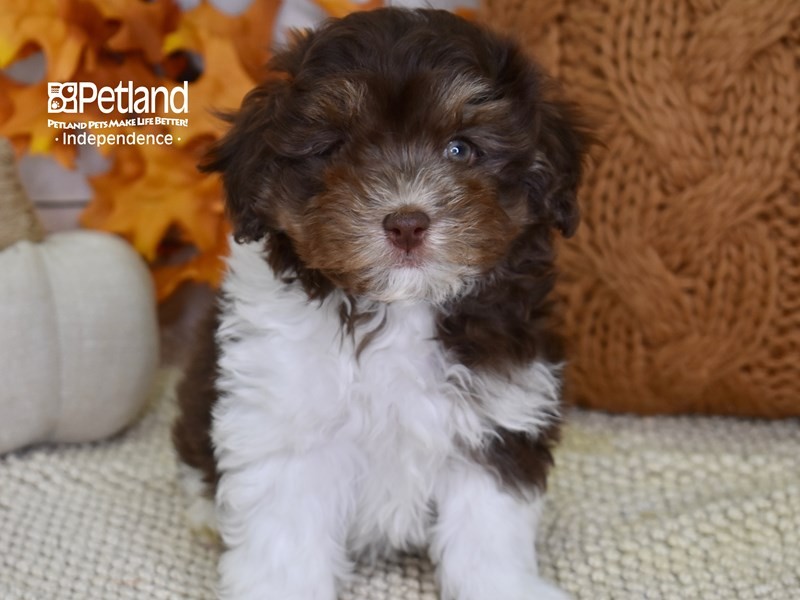
The brown and white Maltipoo represents one of the most striking color combinations in this designer breed, created by crossing a Maltese with a Poodle. These bi-colored dogs typically feature a white base coat with brown patches, though the pattern distribution can vary significantly. While pure white Maltipoos are common due to their Maltese heritage, achieving the brown and white combination requires specific genetic factors from both parent breeds. The brown coloring can range from deep chocolate to lighter café au lait shades, often fading over time due to the progressive graying gene inherited from the Poodle lineage.
Brown and White Maltipoo
Unique Color Pattern
According to Premier Pups, brown and white Maltipoos are considered parti-colored, requiring at least 50% white coat with brown markings. The brown portions can range from deep chocolate to lighter coffee shades. This distinct pattern emerges from specific genetic combinations, with one parent typically being a parti-carrier.
Maintenance Requirements
The brown and white combination requires special grooming attention due to the contrasting colors. The white portions are prone to discoloration and staining, while the brown sections may fade over time to lighter beige tones. Regular brushing helps prevent matting where the colors meet. To maintain the vibrancy of both colors, specialized shampoos designed for bi-colored coats are recommended - whitening formulas for light sections and color-preserving products for brown areas.
Understanding Brown and White Maltipoo Coat Colors and Genetics
Genetic Inheritance Patterns
According to Dogster, true brown Maltipoos possess the bb gene that eliminates black pigmentation, resulting in a pure chocolate color. When combined with white coats from the Maltese parent, the genetic interaction creates distinct patterns. The white coloring stems from a lack of pigment cells, while brown requires specific recessive genes from both parents to manifest.
Color Development Phases
As noted by Premier Pups, the brown portions of bi-colored Maltipoos frequently undergo color evolution during maturation. The initial deep chocolate brown typically lightens to coffee or beige tones due to the progressive graying gene inherited from Poodle ancestry. Meanwhile, the white sections maintain their base color but may require specialized care to prevent environmental discoloration. This color transformation process usually begins during puppyhood and continues through adulthood.
Care and Maintenance for Brown and White Maltipoo Coats
Daily Grooming Protocol
While previous sections covered general maintenance, this section focuses on specific daily care routines. According to Premier Pups, brown and white Maltipoos require separate treatment for each color zone during grooming. The white portions need daily cleaning with tear stain removers around the eyes and face to prevent reddish-brown discoloration. For brown sections, use color-protecting conditioners to minimize fading. Brush both areas separately using different brushes to avoid color transfer.
Nutritional Support
Unlike previous maintenance discussions, this section emphasizes dietary needs for coat health. Dogster notes that maintaining distinct brown and white coloring requires specific nutrients. Feed foods rich in omega-3 and omega-6 fatty acids to preserve the brown pigmentation and prevent yellowing of white fur. Supplements containing biotin and vitamin E help maintain color vibrancy in both sections while supporting overall coat health.
Brown and White Maltipoo Characteristics
Physical Appearance and Markings
While previous sections covered general coat patterns, this section focuses on specific physical traits. According to Premier Pups, brown and white Maltipoos display distinct facial features with the brown coloring often appearing as a "mask" around the eyes and muzzle, while the white extends down the chest and legs. The brown markings typically appear in specific areas like the back, ears, and face, creating a striking contrast against the white base coat.
Breeding Considerations
Unlike previous discussions on genetics, this section examines specific breeding challenges. Dogster notes that producing brown and white Maltipoos requires careful selection of parent dogs carrying both the brown and parti genes. This combination is relatively uncommon, making brown and white Maltipoos more expensive than solid-colored variants, with prices potentially exceeding $2,500. The breeding process often requires multiple generations to achieve the desired brown and white pattern consistently.
Conclusion
Brown and white Maltipoos represent a distinctive and sought-after color combination that requires specific genetic inheritance patterns and dedicated maintenance. These parti-colored dogs feature at least 50% white coat with brown markings, created through careful breeding of parents carrying both brown and parti genes. The research reveals that their unique coloring undergoes natural changes over time, with brown portions typically lightening from deep chocolate to lighter coffee shades while white sections remain stable but prone to environmental staining.
The findings emphasize the importance of specialized care routines for these bi-colored dogs, including separate grooming protocols for brown and white sections, specific nutritional requirements to maintain coat vibrancy, and careful breeding considerations. The distinctive appearance and complex genetic requirements make brown and white Maltipoos relatively rare and more expensive than solid-colored variants. For potential owners, understanding these maintenance needs and color evolution patterns is crucial for proper care and realistic expectations of their pet's appearance over time.